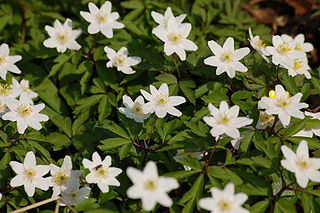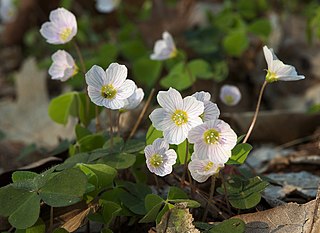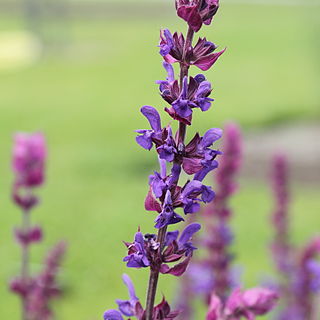
Anemonoides nemorosa, the wood anemone, is an early-spring flowering plant in the buttercup family Ranunculaceae, native to Europe. Other common names include windflower, European thimbleweed, and smell fox, an allusion to the musky smell of the leaves. It is a perennial herbaceous plant growing 5–15 cm (2–6 in) tall.

Oxalis acetosella, the wood sorrel or common wood sorrel, is a rhizomatous flowering plant in the family Oxalidaceae. The specific epithet acetosella refers to its sour taste. The common name wood sorrel is often used for other plants in the genus Oxalis.

Euphrasia, or eyebright, is a genus of about 215 species of herbaceous flowering plants in the family Orobanchaceae, with a cosmopolitan distribution. They are hemiparasitic on grasses and other plants. Both the common and generic names refer to the plant's use in a lotion for treating eye infections, with Euphrasia literally meaning 'good-cheer'.

Myosotis nemorosa is a plant species of the genus Myosotis. They are native to most of mainland Europe.

Portencross is a hamlet near Farland Head in North Ayrshire, Scotland. Situated about three kilometres west of Seamill and about two kilometres south of Hunterston B nuclear power station, it is noted for Portencross Castle.

Euphrasia arguta is a plant from the genus Euphrasia (eyebrights) within the family Orobanchaceae.
Euphrasia ruptura is a presumed extinct plant from the genus Euphrasia within the family Orobanchaceae.

Bellardia trixago is a species of flowering plant in the family Orobanchaceae. It was formerly classified in the family Scrophulariaceae. The only member of the monotypic genus Bellardia, it is known as trixago bartsia or Mediterranean lineseed. This plant is native to the Mediterranean Basin, but it is known in other places with similar climates, such as California and parts of Chile, where it is an introduced species and noxious weed.

Salvia nemorosa, the woodland sage, Balkan clary, blue sage or wild sage, is a hardy herbaceous perennial plant native to a wide area of central Europe and Western Asia.

Euphrasia collina is a perennial herb or subshrub in the genus Euphrasia. Plants grow to between 5 and 60 cm high and have leaves with 1 to 6 teeth per side. The flowers may be white, blue, pink or purple, sometimes blotched with yellow on the lower petal.

Euphrasia alpina is a plant from the genus Euphrasia, in the family Orobanchaceae. Three subspecies are recognized: E. a. alpina, E. a cantabrica, E. a. pulchra. Like all Euphrasia species, E. alpina is hemiparasitic.

Euphrasia officinalis, also known as eyebright or eyewort, is a species of plant in the family Orobanchaceae.

Ireland is in the Atlantic European Province of the Circumboreal Region, a floristic region within the Holarctic.

Euphrasia salisburgensis is a plant in the genus Euphrasia, in the family Orobanchaceae.
Common eyebright is a common name for several plants in the genus Euphrasia and may refer to:

Euphrasia hirtella is a species of flowering plant belonging to the family Orobanchaceae.

Euphrasia micrantha is a species of flowering plant belonging to the family Orobanchaceae.

Draba nemorosa is a species of flowering plant belonging to the family Brassicaceae.















